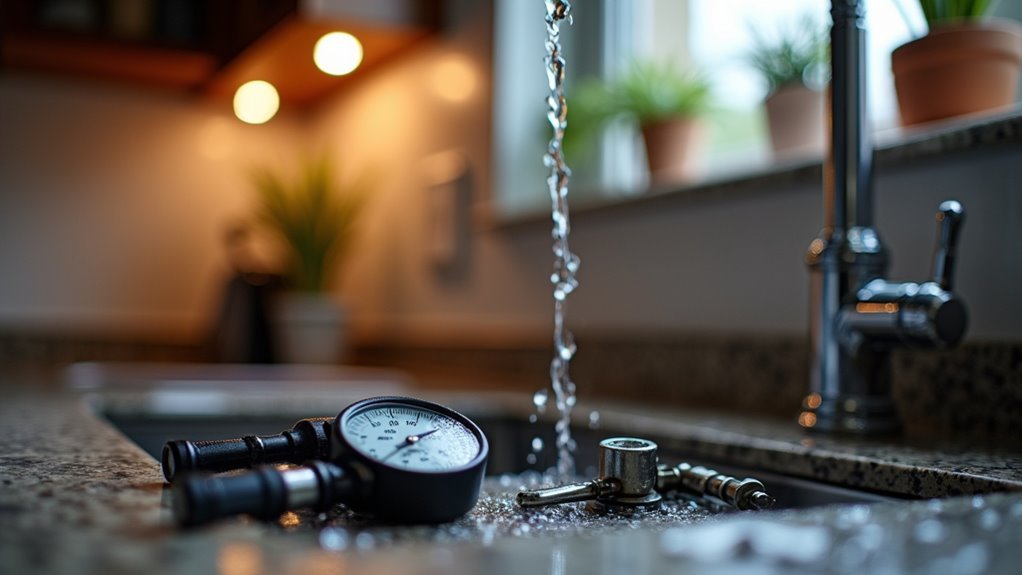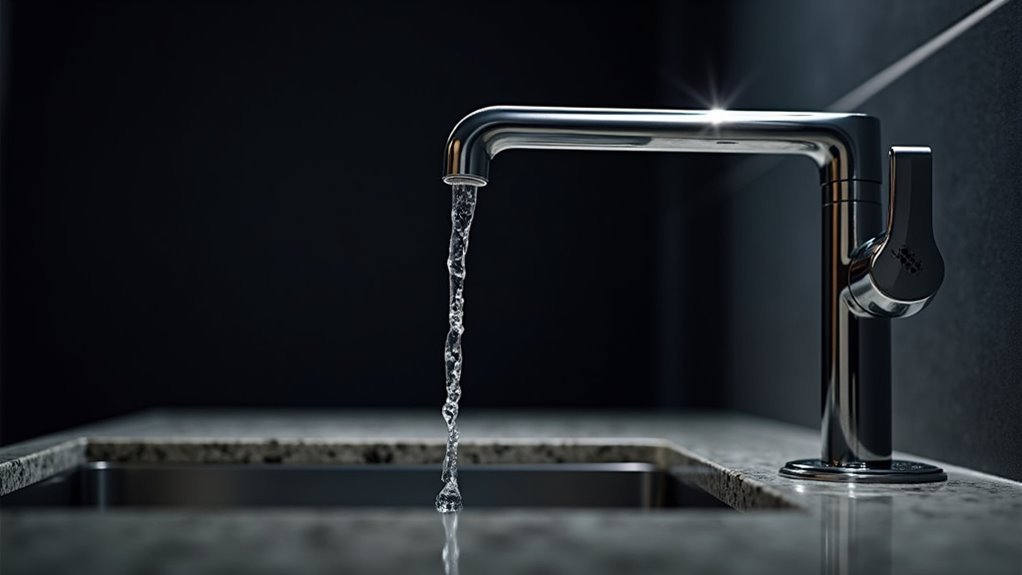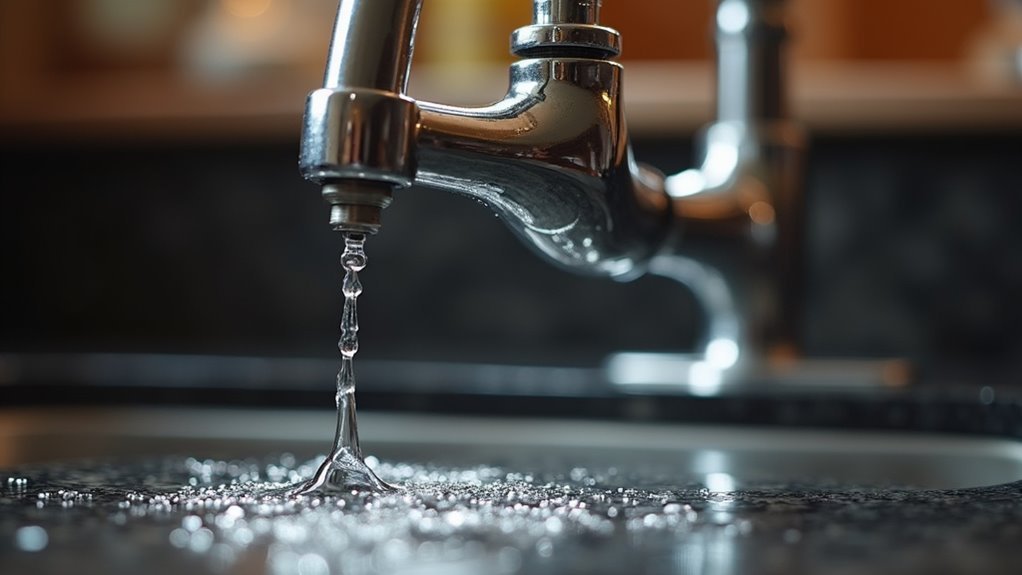You’ve probably ignored that subtle drip from your kitchen faucet, thinking it’s just a minor annoyance that’ll fix itself. But here’s what you don’t realize: that seemingly harmless leak could be costing you hundreds in water bills and potentially thousands in hidden damage to your cabinets and flooring. The good news? Detecting faucet leaks doesn’t require a plumber’s expertise or expensive equipment—if you know what to look for.
Understanding Modern Faucet Types and Their Leak Patterns

Homeowners face different leak challenges depending on their faucet type, and recognizing these patterns can save you time, money, and frustration.
Compression faucets with separate hot and cold handles typically develop spout drips when washers wear out.
Worn washers in compression faucets create the familiar drip-drip-drip from spouts that keeps homeowners awake at night.
Ball faucets, identifiable by their single handle over a rounded cap, leak around the handle due to deteriorated O-rings.
Ceramic-disk faucets control water flow through two ceramic disks, causing spout seepage when disks crack or accumulate dirt.
Cartridge faucets present the most varied symptoms—you’ll notice dripping from the spout or pooling around the base when cartridges fail or seals deteriorate.
Understanding these distinct faucet leaks patterns enables early detection without expensive leak detection technology, promoting effective water conservation while reducing your utility costs through prompt, targeted repairs.
Early Warning Signs Your Faucet Needs Attention
You can spot potential faucet problems before they become costly disasters by watching for specific visual and audible warning signs.
Water stains, discoloration around your faucet base, or mysterious puddles under your sink are clear indicators that something’s wrong and needs immediate attention.
Strange sounds like hissing, bubbling, or dripping when your faucet should be silent also signal internal component issues that won’t fix themselves.
Visual Leak Indicators
When should concern arise about potential faucet leaks? You’ll notice several visual indicators that signal trouble. Constant dripping from your spout wastes up to 3,000 gallons annually per leaky faucet, creating costly utility bills.
Water escaping from pipes often manifests as:
- Damp spots or water stains around the faucet base, indicating worn seals or gaskets requiring immediate replacement
- Puddles forming under your sink or around the fixture, demanding prompt attention to prevent structural damage
- Rust or corrosion on faucet components, revealing prolonged moisture exposure and potential internal deterioration
Don’t ignore unusual sounds like dripping or hissing when your faucet’s turned off. These auditory cues often accompany visible leak signs, confirming water loss that needs professional inspection.
Audible Warning Signals
Three distinct sounds from your faucet can signal developing leaks before visible water damage appears.
An audible dripping sound indicates water escaping at a rate that wastes over 3,000 gallons annually from just one drop per second. You’ll need immediate attention when you hear unusual hissing or whistling noises, which suggest air leaks in your faucet or plumbing system.
Gurgling sounds during operation signal potential blockages that can lead to leaks. Continuous water flow accompanied by rushing water sounds clearly indicates malfunction requiring repair.
Pay attention to sudden increases in noise levels when using your faucet, as these changes often reveal underlying leaks developing within the system that need addressing before costly damage occurs.
Essential Tools for DIY Faucet Leak Detection

You’ll need the right tools to accurately detect faucet leaks before they become costly problems.
Your toolkit should include basic detection equipment like flashlights and adjustable wrenches, advanced diagnostic tools such as moisture meters and infrared cameras, and essential safety gear to protect yourself during inspection and repair work.
Having these three categories of tools ready guarantees you can identify, locate, and safely address leaks efficiently.
Basic Detection Equipment
While professional plumber visits can cost hundreds of dollars, you can detect most faucet leaks yourself with a few essential tools. These basic instruments will help you identify problems before they become costly water damage disasters.
Your leak detection arsenal should include:
- Moisture meter – This device measures moisture levels in walls and cabinets around faucets, revealing hidden leaks that aren’t visible to the naked eye.
- Acoustic leak detection device – These tools use sound waves to pinpoint exact leak locations, detecting even faint dripping sounds in noisy environments.
- Adjustable wrench – Essential for tightening loose connections and testing faucet fittings during your inspection process.
Keep spare O-rings and washers handy for immediate repairs once you’ve identified leak sources.
Advanced Diagnostic Tools
When basic tools aren’t sufficient for complex leak detection scenarios, advanced diagnostic equipment can pinpoint problems with professional-grade accuracy.
Moisture meters measure water levels in materials, helping you detect leaks hidden within walls, ceilings, or floors. Infrared cameras reveal temperature variations caused by moisture presence, allowing non-invasive inspection of suspected areas throughout your plumbing system.
Acoustic leak detection technology uses sound waves to locate leaks in pipes, making it effective for both visible and concealed problems. Ground-penetrating radar (GPR) enhances accuracy for underground leak detection without requiring excavation.
These advanced diagnostic tools work together to create a thorough detection strategy.
You’ll find that regularly using these technologies considerably reduces repair time and costs while preventing extensive water damage to your property.
Safety Gear Essentials
Before attempting any faucet leak detection work, proper safety equipment protects you from injury and guarantees efficient repairs. Safety goggles shield your eyes from splashes and debris while you work on plumbing fixtures. Gloves prevent cuts and keep your hands clean from grime and chemicals during repairs.
Essential safety gear includes:
- Eye protection – Safety goggles prevent chemical splashes and flying debris from entering your eyes during disassembly.
- Hand protection – Quality gloves protect against cuts while maintaining grip on wet surfaces and contaminated components.
- Clean workspace tools – Towels and sponges control spills and maintain visibility of your work area.
Your basic tools require proper handling alongside safety equipment. A sturdy adjustable wrench and complete screwdriver set enable safe component removal without forcing parts or causing damage.
Smart Technology Solutions for Automated Monitoring

As technology advances, you can now rely on IoT-enabled leak detection systems that continuously monitor your faucets’ water flow and pressure patterns.
This smart technology delivers real-time alerts directly to your smartphone when potential leaks occur, enabling immediate action before minor issues become costly disasters.
Advanced moisture sensors positioned near faucets enhance your automated monitoring capabilities by detecting even the smallest leaks early.
Many smart faucets feature automatic shut-off mechanisms that activate upon leak detection, instantly preventing further water loss.
AI algorithms take leak detection further by analyzing your usage patterns alongside sensor data.
This intelligent approach identifies unusual fluctuations and predicts potential leaks before they become critical problems.
Mobile app integration provides instant notifications and historical water usage data, empowering you to manage your water consumption efficiently.
Visual Inspection Techniques for Different Faucet Models
While smart technology offers sophisticated monitoring capabilities, conducting regular visual inspection remains your most reliable method for detecting faucet leaks across different models.
You’ll need to examine each type systematically to catch problems early.
For single-handle faucets, focus on the area around the handle and spout for dripping or pooling water.
Double-handle models require checking that both handles are secure while listening for unusual sounds indicating worn washers.
Essential visual inspection steps include:
- Base examination – Check for moisture or puddles around all faucet bases, as deteriorating seals often cause leaks here.
- Material assessment – Look for visible cracks or corrosion, especially on older fixtures.
- Hidden area detection – Use a flashlight to inspect underneath sinks and behind faucets for concealed moisture spots.
Sound-Based Detection Methods You Can Use at Home
Beyond what your eyes can detect, your ears provide another powerful tool for identifying faucet leaks throughout your home. Sound-based detection methods utilize acoustic sensors that detect escaping water sounds, enabling early identification before damage occurs.
You can start with simple listening techniques by placing your ear close to faucets and pipes, listening for unusual dripping or hissing sounds.
A stethoscope becomes an effective tool for detecting leaks by helping you pinpoint areas where water’s moving through pipes abnormally. When you hear persistent running water sounds with no fixtures operating, this signals potential hidden leaks requiring investigation.
Combining sound-based detection with visual inspections enhances your leak detection effectiveness, ensuring you address both audible and visible indicators promptly for thorough home protection.
Temperature and Moisture Detection Strategies
When moisture seeps into materials around your faucets, it creates detectable temperature variations that reveal hidden leaks before they cause visible damage.
You can leverage this phenomenon using specialized detection equipment that reads these subtle changes.
Thermal imaging cameras detect leaks by identifying temperature differences in surrounding materials, allowing non-invasive inspections of your plumbing systems.
Thermal imaging reveals hidden plumbing leaks through temperature variations without invasive wall or floor inspections.
Meanwhile, moisture meters measure dampness levels in walls, cabinets, and flooring around faucets to pinpoint problem areas.
Here are three effective temperature and moisture detection strategies:
- Combine thermal imaging with moisture meters for enhanced accuracy in leak identification
- Add acoustic sensors to pick up faint leak sounds alongside temperature readings
- Monitor temperature and moisture levels regularly to catch leaks early and prevent extensive water damage
Common Leak Locations and How to Check Them
Since faucet leaks typically develop in predictable locations, you can focus your inspection efforts on the most vulnerable areas to catch problems early.
Start by examining around the spout, under handles, and at the base where water commonly pools or drips. For single-handle faucets, check for leaks around the body and listen for unusual sounds indicating hidden corrosion.
With double-handle faucets, verify handles are tightly secured and inspect packing nuts and o-rings, which are frequent failure points.
Wall-mount faucets offer easier access—look for water stains or puddles under your sink that signal connection leaks.
Regular monitoring of these common leak locations helps prevent water waste and expensive repairs, since even minor leaks waste thousands of gallons annually.
Water Pressure Testing for Hidden Issues
You can identify hidden leaks in your plumbing system by testing for pressure drops that indicate water escaping through damaged pipes or fixtures.
The key lies in selecting the right testing equipment and understanding which detection methods will reveal problems before they become costly repairs.
A simple pressure gauge attached to your outdoor hose bib will help you monitor your system’s baseline pressure and spot irregularities that signal trouble.
Pressure Drop Detection Methods
How can you detect a hidden leak that’s silently draining your water supply and increasing your bills? Pressure drop detection methods offer reliable solutions for water leak detection before costly damage occurs.
You’ll need to monitor your system’s pressure readings consistently, as even minor drops can signal significant plumbing issues.
Here are three effective pressure drop detection techniques:
- Static pressure monitoring – Attach a pressure gauge to your faucet or hose bib and record baseline readings when no water’s flowing.
- Dynamic pressure testing – Measure pressure changes while using multiple fixtures simultaneously to identify system weaknesses.
- Overnight pressure surveillance – Monitor pressure levels during periods of no water usage to detect subtle leaks.
Regular pressure testing helps you catch problems early, preventing extensive repairs and water damage.
Testing Equipment Selection
When selecting the right testing equipment for water pressure detection, you’ll want to prioritize accuracy and ease of use to guarantee reliable leak identification.
Your testing equipment selection should include a quality pressure gauge that reads 0-100 psi, providing precise measurements within the typical 40-60 psi residential range.
Consider investing in a complete pressure testing kit featuring multiple gauges, flexible hoses, and various fittings that attach to outdoor spigots or indoor faucets.
Look for gauges with easy-to-read displays and durable construction that withstand regular use.
Digital pressure meters offer enhanced accuracy compared to analog versions, making water pressure testing more reliable.
Quality equipment guarantees you’ll detect pressure drops effectively, enabling early leak detection before costly damage occurs.
Choose tools that accommodate your specific plumbing configuration for best results.
Step-by-Step Diagnostic Process for Each Faucet Type
Before diving into repairs, you’ll need to systematically diagnose your faucet type to pinpoint the exact source of the leak. Start by turning off your water supply and draining remaining water to prevent spillage during inspection.
Proper faucet diagnosis requires shutting off water supply and identifying your specific faucet type before attempting any repairs.
This diagnostic process helps identify specific leak patterns that affect water usage and repair strategies.
Here’s how to diagnose faucet leaks by type:
- Compression faucets – Check both handles for tight security and inspect the base and spout for drips, which typically indicate worn washers.
- Ball and cartridge faucets – Examine handles and spouts for pooling water or seepage, signaling worn O-rings or faulty cartridge components.
- Ceramic-disk faucets – Look for water around handle areas and spouts, as cracked ceramic disks require complete replacement.
When to Use Professional Detection Equipment
Although basic diagnostic techniques work well for most faucet leaks, certain situations demand professional detection equipment to locate hidden or complex water sources.
You’ll need professional solutions when unexplained water bill increases occur despite visible faucet repairs, or when damp spots appear in walls and ceilings near plumbing fixtures.
Experts use cutting-edge technology like acoustic sensors and thermal imaging cameras to locate leaks within inaccessible areas.
If you suspect foundation-level problems, professionals deploy moisture meters and infrared cameras to detect hidden moisture patterns. Ground-penetrating radar helps identify underground pipe issues without excavation.
When standard visual inspections fail to locate leaks causing ongoing water damage, hiring specialists with advanced equipment guarantees accurate identification, preventing costly repairs and facilitating timely solutions.
Preventive Maintenance to Avoid Future Leaks
Since faucet leaks often develop gradually from component wear and neglect, implementing a consistent preventive maintenance routine will save you considerable time, money, and water damage down the road.
Regular inspections of your plumbing fixtures help identify potential issues before they become costly repairs.
Establish these essential preventive maintenance practices:
- Monthly inspections – Check faucets and connections for signs of wear, corrosion, or moisture around fixtures and under sinks.
- Annual component maintenance – Clean aerators to prevent pressure-increasing clogs and replace worn washers and O-rings periodically.
- Proper handling techniques – Tighten faucet handles gently without over-tightening to prevent damage.
This proactive approach allows you to fix leaks early while maintaining consistent water flow and extending your fixtures’ lifespan considerably.
Cost-Effective Monitoring Systems for Every Budget
Three main categories of leak detection systems accommodate different budgets and technical preferences, ranging from simple $20 acoustic sensors to extensive smart monitoring networks under $100.
You can start with basic acoustic sensors that detect unusual water flow sounds, alerting you to potential leaks without breaking your budget. These cost-effective monitoring systems prove their worth quickly by identifying problems early.
For enhanced convenience, smart IoT-enabled detectors under $100 send real-time alerts directly to your smartphone.
You’ll save money through consistent use, with homeowners averaging 10% reductions in water bills by preventing wasteful leaks. These leak detection devices often feature modular designs, allowing future upgrades as technology advances, ensuring your investment remains valuable long-term while protecting your home from costly water damage.
Building Your Personal Leak Detection Routine
While technology provides excellent monitoring capabilities, developing consistent personal habits forms the foundation of effective leak prevention.
You’ll need to establish a monthly inspection routine that combines visual checks with simple testing methods to catch water leaks early.
Your personal leak detection strategy should include:
- Monthly visual inspections – Check all faucets for visible leaks, irregular flow patterns, and moisture buildup around fixtures and connections.
- Water bill monitoring – Track monthly usage closely, as unexplained increases of just a few dollars can indicate hidden leaks wasting thousands of gallons annually.
- Toilet dye testing – Add food coloring to tank water and wait 15-20 minutes to detect flush mechanism leaks.
Keep basic repair supplies like O-rings and washers handy for immediate fixes.
Regular maintenance of aerators prevents clogs that create pressure inconsistencies and potential leak points.
Frequently Asked Questions
How to Figure Out Where a Leak Is Coming From?
You’ll want to inspect your faucet spout for drips, check around the base for puddles, make certain handles are tight, and add food coloring to toilet tanks to detect hidden leaks.
What Is the Best Method of Leak Detection?
You’ll get the best results by combining acoustic sensors with thermal imaging cameras. These technologies detect sound waves from leaks and temperature variations from hidden moisture, giving you accurate, non-invasive detection.
How to Tell Which Faucet Is Leaking?
You’ll spot the leaking faucet by observing visible drips around each spout and base. Check single-handle faucets at the handle and body, while ensuring double-handle faucets are tightly closed before listening for sounds.
What Is the Most Common Cause of Dripping Faucets?
You’ll find worn-out washers are the most common culprit behind dripping faucets, especially in compression-style faucets. They’re inexpensive to replace but can waste significant water if you don’t address them promptly.





Leave a Reply